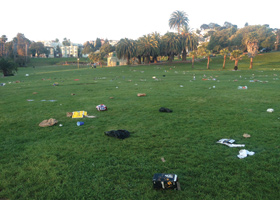Keeping Earth Day Clean

At parks across San Francisco, aka “North America’s Greenest City,” last year’s Earth Day celebrators showed their true colors—and green wasn’t one of them. Despite April 22 being devoted to protecting the planet, partiers at some of the city’s iconic parks left behind mounds of litter, including empty liquor bottles, beer cans, plastic bags and other trash. Disgusted residents who live near the parks sent photos of the aftermath to local publications. Fellow Bay Area residents who viewed the photos online added that more heaps of trash could be found in areas not shown in the images. Others argued the real issue is a less-than-adequate number of trash cans.
“In some parks, with any type of celebration, including some Earth Day events, we do have challenges of trash and vandalism,” says Connie Chan, deputy director of public affairs at the San Francisco Recreation and Parks department. “In the occasion of Earth Day celebrations, it often depends on what people are doing to celebrate the Earth. Many of our community members decide to partner with us and celebrate the Earth with their efforts to beautify our parks, which we truly appreciate. But we also have been disappointed in the past that sometimes it was not the case for everyone during an Earth Day celebration.”
Despite the presence of some garbage-laden scenes on Earth Day, conservationists across the nation are ditching the excuse to party and are proactively re-beautifying their local landscapes. For example, the California Coastal Commission invites all Californians to take part in an act of coastal stewardship on Earth Day by cleaning up any natural site—be it a neighborhood, favorite park, local beach or even an area around the office. All water flows downhill, the commission notes, “so any trash you clean up will be that much less trash that has the opportunity to become marine debris.”
In New York, the Onondaga County Resource Recovery Agency (OCRRA) Earth Day Litter Cleanup brought in over 57,500 pounds of trash last year. In the 21 years since OCRRA began the Earth Day cleanup, more than 2,093,880 pounds of litter have been removed from the community’s streets and green spaces. Action-based events like these and countless other community-based Earth Day cleanups can be found everywhere from the salty shores of Mahaulepu Beach in Kauai, Hawaii, to the peaks of New England’s Wachusett Mountain, which is home to trees over 350 years old.

There are also large-scale Earth Day projects—like the Earth Day Network’s goal to plant 10 million trees via the “Canopy Project.” The Canopy Project was born in 2010 to honor the 40th anniversary of Earth Day.
“The Canopy Project was launched a couple of years ago and it started with a partnership with 20th Century Fox,” says Franklin Russell, director of Earth Day at the Earth Day Network. “We worked with James Cameron and his film Avatar to plant a million trees around the world. Since then, the program has evolved and just recently, we made a commitment to try to plant 10 million trees in the next 10 years.”
th Day Network’s “A Billion Acts of Green” is no small matter, either. In fact, it has quickly become the largest environmental service campaign in the world. In just two years, A Billion Acts of Green has steadily built planet-saving initiatives by inspiring and rewarding ecologically friendly commitments from individuals, organizations, businesses and governments. Now that the campaign has met its initial goal of inspiring one billion environmental actions around the world, it has set its sights on accumulating another billion. While achieving this new two-billion-act goal, the campaign will alter the focus to more specific environmental problems and pledges—including voting for environmentally friendly candidates, planting trees and recycling electronic waste (more than two million tons of which is discarded in the U.S. each year). Individuals and organizations are encouraged to document other actions they’re taking to protect the environment by logging them into Earth Day Network’s improved online registration tool. Every seemingly small action “adds up to big dividends for the planet,” the organization states on their website.
With over 20,000 partners around the world, “our goal as an organization is to grow and diversify the environmental movement,” Russell says. “Earth Day Network is a continuation of the original Earth Day, where we’re trying to help educate people about issues, bring more into the movement and hopefully make the world a better, more sustainable, place.”

